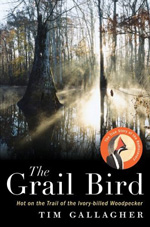Review of "The Grail Bird: Hot on the Trail of the Ivory-billed Woodpecker"

Author(s): Tim Gallagher
Published: May 2005, Houghton Mifflin, ISBN: 0618456937
 by James A. Huggins, Ph.D., University Professor & Director of the Hammons Center for Scientific Studies
by James A. Huggins, Ph.D., University Professor & Director of the Hammons Center for Scientific Studies
June 158, 2005 -
Tim Gallagher is a professional wildlife photographer who has, for the past 15 years, served as editor of the Cornell Laboratory of Ornithology’s quarterly-published journal entitled Living Bird. In this book Gallagher recounts his fascination for the ivory bill and chronicles some of his research concerning the bird as well as his travels to many of the ivory-bill's former haunts to dialogue with those who have, from year’s past, interacted with the bird. Gallagher does a good job of pulling together what I would call “tales of the Kent” (my emphasis) though not so well as Philip Hoose in his 2004 book, The Race to Save the Lord God Bird (see book review at this site). However, his is not a book of a bird believed extinct but a journey to its rediscovery. Therefore The Grail Bird is not intended to serve the same purpose as that of Hoose’s book. In contrast to Hoose in the Race to Save the Lord God Bird, Gallagher does a much better job of presenting recent sightings that really, in light of the recent discovery of this bird, seem quite credible. But I guess hindsight is a marvelous thing when putting your case together. I truly hope this bird will be found to exist in Georgia, Florida and Louisiana. The account of the author’s conversation with Nancy Tanner, wife of ivory-billed expert and former University of Tennessee professor Jim Tanner, is particularly heart-warming and enlightening. I particularly enjoyed the human interest side of the story that enlightened us on how the birth of Jim Tanner’s son had kept him off the ill-fated USS Indianapolis and the potential for a fate not unlike that of the 900 or so crew members that died of thirst, exposure and sharks while awaiting rescue. This same son, David, apparently made a trek with him into Mexico to search for the ivory bill’s larger cousin, the imperial woodpecker. In his search for evidence of the woodpeckers' continued existence Gallagher is also found interrogating those who have reported recent sightings. By God’s grace and his own dogged determination, he was one of the first to see and document an ivory-billed woodpecker in Arkansas in 2004. He and the team that was subsequently put together, after more than 60 years since the last officially confirmed sighting in the United States, were able to document that at least one male ivory-billed woodpecker still endures in the bottomland swamps of eastern Arkansas. Having spent my childhood traipsing through the bottomland forests of the St. Francis and Cache rivers of northeast Arkansas, I guess I should not have been surprised by this finding; I was, nonetheless. Also, I must confess that there was a bit of pride that welled up within me when I realized that it was an area very near my home that has apparently remained a refuge for this magnificent creature.
The story builds to a crescendo as the rediscovery approaches. Several wildlife professionals are built into the plot: Van Remsen, Kurt Fristrup, David Laneau, Richard Hines, Larry mallard, A number of other interesting and little known characters, including Mary Scott, Kenn Duke, Bob Russell, are skillfully woven into the plot; each showing amazing devotion to the avian world. Of course, Bobby Harrison and Gene Sparling, the other two of the triumphant trio to discovery an ivory-billed, deserve top billing in this exciting tale of rediscovery. Harrison is quite the character and his devotion to this project is unflappable. Sparling is the self made naturalist and quiet hero who first sights the woodpecker and leads the others to its documentation. David Laneau, a professor at the University of Arkansas Little Rock is the man who eventually puts the woodpecker on the film clips that many of us have watched. His devotion to this project is also unshakable. Gallagher is quick to give credit where credit is due as he presents this ongoing story as a team effort.
The ivory billed woodpecker has truly been, with the obvious reference being to the search for the Holy Grail, a “grail” bird since the heretofore believed “to little to late” efforts to save it from extinction over sixty years ago. Numerous sightings have been advertised over the years but none had been deemed reliable. The stakes were high for the bird and for the credibility of those who cried “wolf”. For the bird, a rush of people to see this celebrity could prove fatal; without a verified woodpecker, the death knell for a reputation could easily sound. While the ivory-billed has perhaps made a career or two already and holds the potential for making the careers of a few more should a viable population have been discovered there was also the possibility of ruining a couple. Verification eventually came as a result of a rigorous year-long search in the Cache River and White River National Wildlife Refuges involving more than 50 experts and field biologists working together as part of what is now known as the Big Woods Conservation Partnership. The findings include multiple sightings of the elusive woodpecker and frame-by-frame analyses of brief video footage.
In reference a comment by Richard Hines concerning even recent destruction of hardwood forests in Arkansas, I can remember the time when soybeans hit $10 per bushel and I know that the sound of trees being felled that more soybeans could be planted was not an exaggeration. We have as a society made some grievous errors as relates to our environment and its preservation and protection. I believe Gallagher to be correct in his evaluation that southern bottomland forests have been the most neglected among the habitats that our nation has attempted to preserve though the formation of national preserves and park systems. It is time that we make some attempt to rehabilitate and reestablish these forest ecotomes and the aesthetic treasures they may yet hold. Despite Mary Scott’s acclamation that as a species we have never been able to do the right thing, this turn of events almost gives me hope that as a society we may yet be able to halt the relentless pressure we place on the other creatures of our world. Indeed, this is a momentous discovery and Gallagher’s journey and journal should be of interest to all those who love what is left of God’s creation.

